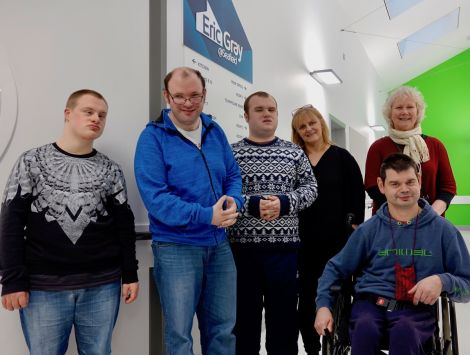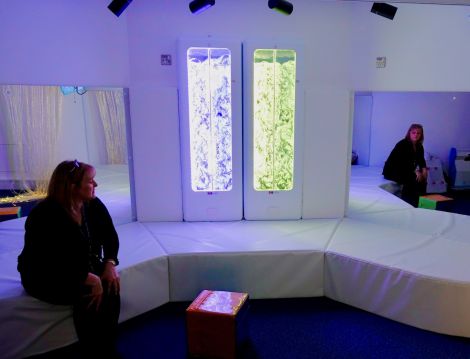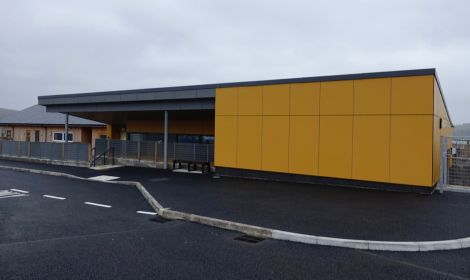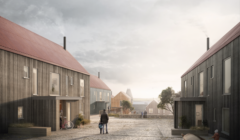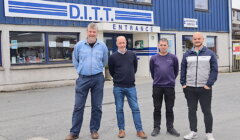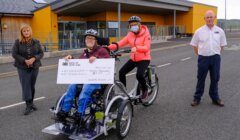Council / Emotions run high as new Eric Gray centre prepares to open
The long-awaited launch of the facility at Seafield will mark the end of a process spanning over a decade.
ADULTS with learning difficulties in Shetland are in line for an excellent new year present when the new support centre, dubbed the Eric Gray@Seafield, receives its “soft launch” in mid-January.
Although it has the same registered capacity of 77 as the old Eric Gray Resource Centre (EGRC) across the road, the replacement centre has the capacity to expand its intake, while the old building was operating at capacity.
The Lerwick building – which has been delivered on time and on budget – will also eventually replace Gressy Loan and dovetail with the Newcraigielea in its provision for adults with learning disability, autistic spectrum disorder and complex needs.
Adult services presently looks after 62 people at the EGRC and that number will rise to 68 once the move is complete. Of these 19 require substantial support, meaning one or two carers per user.
Changing demographics with an ageing population of people who require support and more disabled youngsters surviving into adulthood, led the service to “future proof” the establishment by building in extra capacity.
Equipment and furniture is presently being flitted between the two centres and EGRC will close on Monday for Christmas for a long break while things continue to be prepared for service users in the new premises.
As well as two-metre wide corridors which are also double height, a large car park and a variety of large internal spaces for a variety of activities, a lot of emphasis has also been placed on providing chill out areas where service users can take their ease.
According to adult services executive manager Clare Scott and team leader Connie Russell, parents, carers and service users alike who have previewed Eric Gray@Seafield have been extremely enthusiastic and sometimes very moved by their visit.
Become a member of Shetland News
Scott said: “We have waited a long time for this. The feasibility study started in 2008 and it’s been a long 10 year period.
“Some of the carers were very emotional and we did not have to explain to the carers and parents about each piece of equipment, they could see the advantages for themselves.
“It’s about giving people the opportunity to have a choice and participate in life long learning. It’s about giving them a meaningful life.”
She also paid tribute to the “very supportive community” and the carers and parents who have helped raise £64,000 already for additional equipment for the centre that is not covered by the statutory obligations of Shetland Islands Council, who spent £5.6 million on the new unit.
The extra space is one of the main improvements of Eric Gray@Seafield.
“In the old building two wheelchairs could never pass in the corridor. Circulation space was one of the main things we looked at in terms of trying to make it physically accessible to everyone with a whole range of different movements,” said Russell.
With some 70 rooms over the 1,800 square metres of the centre, a host of new technology innovations will improve the safety, security and lives of service users.
Staff looking after the most vulnerable users are issued with pull toggle wireless alarms that immediately alert front desk staff to their location and the fact that assistance is needed.
Magnetic lock doors can be used by staff to seal off parts of the building to provide security for users engaged in certain activities or if parts of the building are hired out to groups ‘out of hours’.
Russell has been busy planning and considering umpteen aspects of the building along with user groups and a lot of reflection has clearly gone into the unit.
The Eric Gray@Seafield logo, which was a combined effort by six groups, is itself intended to provide a visual reminder of the building to users, just over half of whom are living with family with the others in supported accommodation, which is mostly centred in Lerwick.
Service users are aged 18 to 73 and there is a senior Gold Group plus a Silver Group of users in their 60s who can take part in all the external activities that any 60 something may be interested in.
The nerve centre of Eric Gray@Seafield is the large reception/office where patient files and security and emergency systems are housed.
The central part of the building is devoted to a block of bathrooms and assisted bathrooms which provide extra space for users and carers and ceiling mounted H-track that allows hoist access throughout that space.
Water taps, like the lights, can be locked in order to prevent people from drinking excessively.
Class One is the biggest space and is intended as the primary area for wheelchair users – a huge improvement from Gressy Loan which “has no space and is at the top of a hill”.
There are alcoves at the sides of the already double-width corridors for storage of wheelchairs, walkers and height adjustable beds.
Large easily-recognisable graphics by Art Machine mark out the doorways to various recreational areas such as the trampoline room which is intended for “rebound therapy” which is good for autistic people to “self-regulate”.
Like many of the other rooms, this has a tracker beam that can accommodate swings including a low-level swing people can lie on.
A gym is equipped with a spinning bike and recumbent spinning bike for those with low muscle tone and a rowing machine. These can be stowed to make way for activities like yoga.
There is a workshop that is in use for some of the centre’s three enterprises. This inside room is accessible all year round unlike the facility at the EGRC which is in the garden and unsuitable for winter use. Cat beds, clothes poles and Christmas decorations are all produced.
Two of the most innovative rooms are the Dark Room and White Room which gives users the chance to relax and enjoy a heated, musical waterbed (Dark Room) and colour changing string walls and water tubes which can be controlled from iPad or a large colour-coded control box.
IT is used heavily throughout the building from bluetooth music that can be controlled with a wave of a hand to projectors and even an app that allows users to build a picture of their day which can be taken home and showed to friends and family.
The training kitchen, like many of the other areas, is built to be height adjustable so that users can work at their own height for ease and comfort. Paws pet food is produced, as are jams and chutneys for in-house consumption. It is planned to grow some of the kitchen’s own fruit and veg in a polycrub.
There are also an art room and a medication room and what will no doubt turn out to be one of the most popular areas – the cafe. With its own cooking facilities and servery, it is more than twice the size of that at the EGRC – although much of the food will continue to be supplied by nearby Edward Thomason House and Taing.
Tables and chairs can be put away and the cafe becomes another large recreational space that can be used for dancing and the like.
To complement the impressive interior there are a number of garden areas that will be completed in consultation with the users. The east facing garden has several gazebos one of which has a large window looking to the east.
These areas offer users privacy and general relaxation where they can wind down after participating in other activities.
Become a member of Shetland News
Shetland News is asking its readers to consider paying for membership to get additional perks:
- Removal of third-party ads;
- Bookmark posts to read later;
- Exclusive curated weekly newsletter;
- Hide membership messages;
- Comments open for discussion.
If you appreciate what we do and feel strongly about impartial local journalism, then please become a member of Shetland News by either making a single payment, or setting up a monthly, quarterly or yearly subscription.






